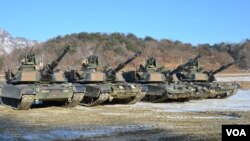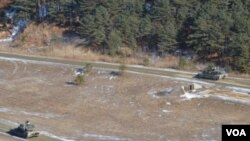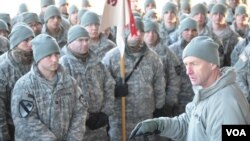POCHEON, SOUTH KOREA —
At a time of rising tensions on the Korean peninsula, a quartet of U.S. Army “Abrams” M1-A2SEP tanks rolls onto the frozen ground of the Rodriguez Live Fire Range near the DMZ during one of the coldest days of the winter.
The tanks and their crews, from Dragon Company of the 1st Battalion’s 72nd Armor Regiment (1-72 AR), are a small but lethal component of the U.S. Army's 2nd Infantry Division stationed close to the tense border separating North and South Korea.
The division has the unenviable task of holding off - until reinforcements arrive - a much larger enemy force, should there be an invasion similar to the one that began the Korean War in 1950.
The tankers' advanced qualification exercise (known as a gunnery table XII) not only involves the crews inside the 70-ton 1,500-horsepower vehicles, but 400 other support personnel scattered across the range, including those in an observation tower and a large heated tent that serves as the battalion tactical operations center.
Inside the tent, a situation report arrives from a tank platoon that they have completed movement from one map reference to another.
“Moving forward phase line blue, phase line crimson,” shouts a soldier.
“Phase line blue, phase line crimson!” echoes a chorus of other uniformed personnel to ensure everyone in the center is aware of the location of the units.
"Currently the second platoon from our Dragon Company, an armored company, has occupied the range and is conducting their engagement area development and is going to move down the lane to engage enemy targets and destroy them," explains Capt. Joshua Jones, an assistant operations officer with the 1-72 AR.
Minutes later huge booms resonate across the range. The Abrams are firing their 120 millimeter cannons. The explosions can also be faintly heard by the North Korean military just a dozen kilometers away.
The big rounds are also accompanied by bursts from the tanks' 50 caliber heavy and 7.62 millimeter coaxial machine guns.
Keeping watch over key route to Seoul
These tanks, with a top speed of 68 kilometers per hour, are in the range of North Korean artillery.
Should there be an enemy invasion, the Abrams of Dragon Company, presumably at that point under heavy fire, would stand between one of the largest armies in the world and some 25 million civilians in the Seoul metropolitan area, just 30 kilometers to the south.
These qualification trainings are meant to ensure that the North Koreans would face some of the U.S. Army's highest-rated tank crews.
They are being graded on “the time it takes to acquire the target, the time to shoot the target and then accuracy,” explains battalion commander Lt. Col. Matthew Holly. “For tanks it's pretty easy. They either fire and hit it and it goes down or they missed, in which case they have to re-fire. And that re-fire will subtract points away from the total score."
The platoon fires 18 rounds and hits all 18 targets - an infrequent occurrence - earning praise from the 2nd Infantry Division's commander, Major General Edward Cardon.
"Out here on these tank ranges when you saw the way that these tankers were shooting that's exactly the kind of formations that we need that are a strong, credible deterrent, “ Cardon says during a VOA interview. “I don't know what the North Koreans will do. But I do know one thing. When we're asked to do something, I want to make sure we can deliver and deliver with the expectation that American fighting forces are known for."
Unique division with a long history in Korea
The 2nd Infantry is one of the U.S. Army's most decorated divisions, having engaged in four wars, going back to World War I.
It was the first unit to reach the Korean peninsula directly from the United States after the North Koreans crossed into the South on June 25, 1950, sparking three years of devastating combat that ended in a stalemate.
The 2nd Infantry has been patrolling close to the DMZ since 1965, as the decades continue to roll by with the two Koreas remaining divided and technically still in a state of war.
It is the Army's only remaining forward-deployed division and unlike any other U.S. Army division, the 2nd Infantry is composed partly of foreign soldiers.
"When you have blood and treasure of the United States committed with the blood and treasure of (South) Korea, together that is a powerful symbol of unity that, I think, has helped the deterrence and the stability of this region of the world for decades," says Maj. Gen. Cardon.
Currently about 1,000 South Korean troops serve in the U.S. 2nd Infantry Division. That is a small fraction of the half million total active personnel in the South Korean military.
Collaboration key to South Korean security
Senior security strategy researcher Hong Hyun-ik, at the Sejong Institute in Seoul, says despite the huge economic disparity between the two Koreas, the South likely would not be able to repel the North without such American units as the 2nd Infantry Division.
Hong contends it would be relative easy for Seoul to be captured by the North should Pyongyang again start a war. Taking this into consideration, he explains, even though South Korea “desires to have an independent defense posture it knows it must rely on U.S. forces here to have a sufficient deterrence.”
Unlike the draw-down of U.S. forces in Iraq and Afghanistan, there are no such plans in South Korea.
But change is looming. Wartime operational control of all forces here is to shift from the U.S. military to South Korea by December, 2015.
In the meantime, 2nd Infantry has been receiving additional modernized heavy combat equipment and increasing combined training with South Korean forces.
Additional reporting from Youmi Kim in the VOA Seoul bureau
The tanks and their crews, from Dragon Company of the 1st Battalion’s 72nd Armor Regiment (1-72 AR), are a small but lethal component of the U.S. Army's 2nd Infantry Division stationed close to the tense border separating North and South Korea.
The division has the unenviable task of holding off - until reinforcements arrive - a much larger enemy force, should there be an invasion similar to the one that began the Korean War in 1950.
The tankers' advanced qualification exercise (known as a gunnery table XII) not only involves the crews inside the 70-ton 1,500-horsepower vehicles, but 400 other support personnel scattered across the range, including those in an observation tower and a large heated tent that serves as the battalion tactical operations center.
Inside the tent, a situation report arrives from a tank platoon that they have completed movement from one map reference to another.
“Moving forward phase line blue, phase line crimson,” shouts a soldier.
“Phase line blue, phase line crimson!” echoes a chorus of other uniformed personnel to ensure everyone in the center is aware of the location of the units.
"Currently the second platoon from our Dragon Company, an armored company, has occupied the range and is conducting their engagement area development and is going to move down the lane to engage enemy targets and destroy them," explains Capt. Joshua Jones, an assistant operations officer with the 1-72 AR.
Minutes later huge booms resonate across the range. The Abrams are firing their 120 millimeter cannons. The explosions can also be faintly heard by the North Korean military just a dozen kilometers away.
The big rounds are also accompanied by bursts from the tanks' 50 caliber heavy and 7.62 millimeter coaxial machine guns.
Keeping watch over key route to Seoul
These tanks, with a top speed of 68 kilometers per hour, are in the range of North Korean artillery.
Should there be an enemy invasion, the Abrams of Dragon Company, presumably at that point under heavy fire, would stand between one of the largest armies in the world and some 25 million civilians in the Seoul metropolitan area, just 30 kilometers to the south.
These qualification trainings are meant to ensure that the North Koreans would face some of the U.S. Army's highest-rated tank crews.
They are being graded on “the time it takes to acquire the target, the time to shoot the target and then accuracy,” explains battalion commander Lt. Col. Matthew Holly. “For tanks it's pretty easy. They either fire and hit it and it goes down or they missed, in which case they have to re-fire. And that re-fire will subtract points away from the total score."
The platoon fires 18 rounds and hits all 18 targets - an infrequent occurrence - earning praise from the 2nd Infantry Division's commander, Major General Edward Cardon.
"Out here on these tank ranges when you saw the way that these tankers were shooting that's exactly the kind of formations that we need that are a strong, credible deterrent, “ Cardon says during a VOA interview. “I don't know what the North Koreans will do. But I do know one thing. When we're asked to do something, I want to make sure we can deliver and deliver with the expectation that American fighting forces are known for."
Unique division with a long history in Korea
The 2nd Infantry is one of the U.S. Army's most decorated divisions, having engaged in four wars, going back to World War I.
It was the first unit to reach the Korean peninsula directly from the United States after the North Koreans crossed into the South on June 25, 1950, sparking three years of devastating combat that ended in a stalemate.
The 2nd Infantry has been patrolling close to the DMZ since 1965, as the decades continue to roll by with the two Koreas remaining divided and technically still in a state of war.
It is the Army's only remaining forward-deployed division and unlike any other U.S. Army division, the 2nd Infantry is composed partly of foreign soldiers.
"When you have blood and treasure of the United States committed with the blood and treasure of (South) Korea, together that is a powerful symbol of unity that, I think, has helped the deterrence and the stability of this region of the world for decades," says Maj. Gen. Cardon.
Currently about 1,000 South Korean troops serve in the U.S. 2nd Infantry Division. That is a small fraction of the half million total active personnel in the South Korean military.
Collaboration key to South Korean security
Senior security strategy researcher Hong Hyun-ik, at the Sejong Institute in Seoul, says despite the huge economic disparity between the two Koreas, the South likely would not be able to repel the North without such American units as the 2nd Infantry Division.
Hong contends it would be relative easy for Seoul to be captured by the North should Pyongyang again start a war. Taking this into consideration, he explains, even though South Korea “desires to have an independent defense posture it knows it must rely on U.S. forces here to have a sufficient deterrence.”
Unlike the draw-down of U.S. forces in Iraq and Afghanistan, there are no such plans in South Korea.
But change is looming. Wartime operational control of all forces here is to shift from the U.S. military to South Korea by December, 2015.
In the meantime, 2nd Infantry has been receiving additional modernized heavy combat equipment and increasing combined training with South Korean forces.
Additional reporting from Youmi Kim in the VOA Seoul bureau









